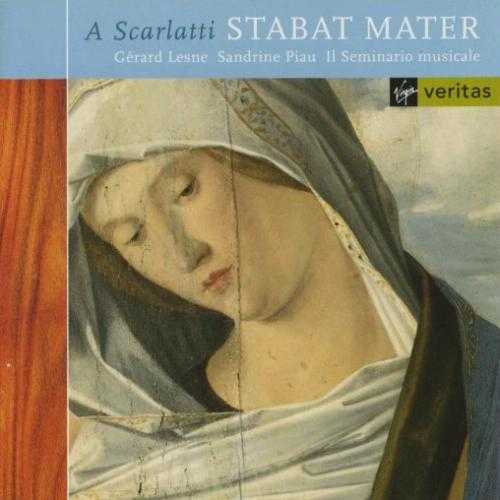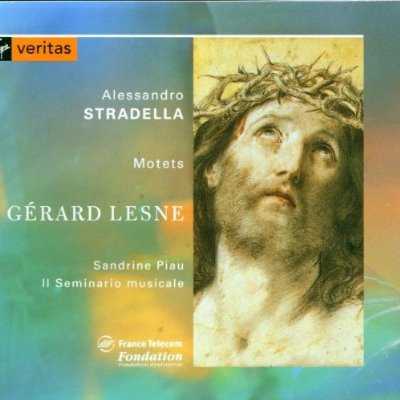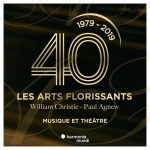
Performer: Il Seminario Musicale, Sandrine Piau, Gerard Lesne
Composer: Alessandro Scarlatti
Audio CD
SPARS Code: DDD
Number of Discs: 1
Format: FLAC (image+cue)
Label: Virgin Veritas
Size: 311 MB
Recovery: +3%
Scan: yes
# Salve Regina No. 5, for soprano, 2 violins, viola & continuo
Composed by Alessandro Scarlatti
with Gerard Lesne, Il Seminario Musicale
# Stabat Mater, for soprano, alto, 2 violins & continuo
Composed by Alessandro Scarlatti
with Sandrine Piau, Gerard Lesne, Il Seminario Musicale
# Quae est ista, motet for chorus, 2 violins & continuo
Composed by Alessandro Scarlatti
with Sandrine Piau, Gerard Lesne, Il Seminario Musicale
01. Salve Regina: Salve Regina
02. Salve Regina: Ad te clamamus
03. Salve Regina: Ad te suspiramus
04. Salve Regina: Eia ergo, advocata nostra
05. Salve Regina: Et Jesum benedictum
06. Salve Regina: O clemens
07. Stabat Mater: Stabat Mater (soprano,alto)
08. Stabat Mater: Cuius animam gementem (soprano)
09. Stabat Mater: O quam tristis et afflicta (alto)
10. Stabat Mater: Quae maerebat (soprano, alto)
11. Stabat Mater: Quis est homo (soprano)
12. Stabat Mater: Quis non posset contristari (alto)
13. Stabat Mater: Pro peccatis suae gentis (soprano)
14. Stabat Mater: Vidit suum dulcem natum (soprano, alto)
15. Stabat Mater: Pia Mater (soprano)
16. Stabat Mater: Sancta Mater (alto)
17. Stabat Mater: Fac ut ardeat (soprano)
18. Stabat Mater: Tui nati vulnerati (soprano, alto)
19. Stabat Mater: Fac me vere tecum flere (alto)
20. Stabat Mater: Virgo virginum (soprano)
21. Stabat Mater: Fac ut portem (alto)
22. Stabat Mater: Inflammatus et accensus (soprano)
23. Stabat Mater: Fac me cruce (alto)
24. Stabat Mater: Quando corpus morietur (soprano, alto)
25. Stabat Mater: Amen (soprano, alto)
26. Quae est ista (motet à 3 for soprano, alto, tenor, 2 violins and continuo): Quae est ista (alto)
27. Quae est ista (motet à 3 for soprano, alto, tenor, 2 violins and continuo): Haec est aurora (soprano, alto, tenor)
28. Quae est ista (motet à 3 for soprano, alto, tenor, 2 violins and continuo): Unde formae tam bellae (soprano)
29. Quae est ista (motet à 3 for soprano, alto, tenor, 2 violins and continuo): Hanc auroram conflagrans ardore (soprano)
30. Quae est ista (motet à 3 for soprano, alto, tenor, 2 violins and continuo): Procul quaeso torpores (tenor)
31. Quae est ista (motet à 3 for soprano, alto, tenor, 2 violins and continuo): O nimis clara lux (tenor)
32. Quae est ista (motet à 3 for soprano, alto, tenor, 2 violins and continuo): Quis tuam decantabit (alto)
33. Quae est ista (motet à 3 for soprano, alto, tenor, 2 violins and continuo): Ave lactea (alto, soprano, tenor)
Another Sublime CD from Lesne and Piau
Chances are, if you’re a screaming Scarlatti groupie like me, you already have a recording of his glorious Stabat Mater, hopefully the performance by Emma Kirkby and Daniel Taylor (Theatre of Early Music) that I reviewed some time ago. This performance by Gerard Lesne and Sandrine Piau (Il Seminario Musicale) is on a par with that one… exquisite, in short … and just different enough to justify having both, as you might have two CDs of any immortal masterwork.
The antiphon “Salve Regina” is one of four antiphons traditionally sung at Compline as part of the monastic recital of all the psalms according to the liturgical calendar. Obviously Scarlatti wasn’t writing for monks, at his historical moment, but he did write at least 6 settings of the Salve Regina text. Chances are, therefore, that you don’t have a duplicate performance of this music, which here is sung with meditative serenity (for Baroque, that is) by alto Gerard Lesne, with obbligatos by two violins. Such alto parts were usually sung in Alessandro Scarlatti’s era by ‘intact’ males rather than by castrati. It’s annoying to read bugbears decrying the preference these days for male altos,derided as “falsettists.” There’s nothing false about using all the possibilities of a voice, and there’s absolutely nothing false-sounding about Gerard Lesne’s singing. Lesne occasionally descends in his alto range to pitches that are clearly “tenor” in timbre, without exposing a break.
The ultimate reason why “Scarlatti nuts” will need this CD is the motet “Quae est ista” for three voices (SAT). Motets as such were out of fashion in the very early 18th Century, but this one was published in Amsterdam in 1707. It’s a showcase of Scarlatti’s mastery of the intricate polyphony of the older musical “wisdom.” It’s also a showcase for the athletic vocal gyrations of the three singers — show-stopper fiery passage-work. Don’t listen to it when you’re trying to fall asleep!



